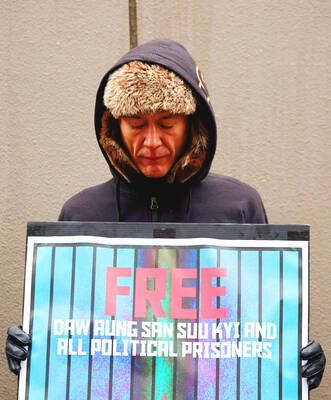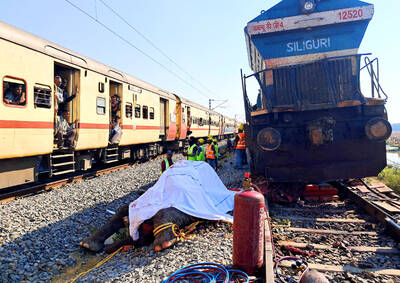Dolphins have been herded into a cove as part of an annual hunt in the Japanese seaside town made famous by an Oscar-winning documentary about their slaughter, conservationist group Sea Shepherd said yesterday. A town official said none were killed.
The dolphin hunt at Taiji, documented in The Cove, begins on Sept. 1 every year. The boats returned empty on Wednesday, but on Thursday, some dolphins were corralled into the inlet, according to anti-whaling group Sea Shepherd and a fishing official in Taiji.
The official in charge of media queries at the Taiji fishing organization said a handful of dolphins were kept for aquariums, but the rest were set free yesterday morning. He declined to give details.
He said the criticism the town has received from the West was unfair because residents were merely trying to make a living, and the rocky landscape made it difficult to go into farming or livestock.
Sea Shepherd said it has been monitoring Taiji with a small crew of Australians, New Zealanders, Americans and Japanese this week.
Ric O’Barry, who stars in The Cove, has gathered about 100 people in Tokyo, including supporters from abroad, to protest the dolphin slaughter. He took a petition with 1.7 million signatures from 155 nations to the US embassy on Thursday.
“The dolphins need defenders at the cove today and tomorrow,” said Michael Dalton of Sea Shepherd in a statement from Taiji. “If you came to Japan to save dolphins, the place to be is Taiji and the time to be here is now.”
O’Barry, 70, the former dolphin trainer for the 1960s Flipper TV show, has received threats from a violent nationalist group and skipped going to Taiji this year, a trip he makes every year to try to save the dolphins.
He said he had been advised by Japanese authorities not to go to Taiji, and repeatedly stressed that he does not want confrontation.
He was flanked by police, as well as supporters, when he went to the US embassy. But some of his supporters said they are headed to Taiji.
Nationalist groups say criticism of dolphin hunting is a denigration of Japanese culture.
The Japanese government allows a hunt of about 20,000 dolphins a year, and argues that killing them — and whales — is no different from raising cows or pigs for slaughter. Most Japanese have never eaten dolphin meat and, even in Taiji, it is not consumed regularly.
The government is also critical of Sea Shepherd, which has harassed Japanese whaling ships. In July, a Tokyo court convicted New Zealander Peter Bethune, a former Sea Shepherd activist, of obstructing a Japanese whaling mission in the Antarctic Ocean, assault, trespassing and other charges. He was not sent to prison and was deported.
The Cove, which won this year’s Academy Award for best documentary, depicts a handful of fishermen from the town of Taiji who scare dolphins into a cove, where they kill them. Other Japanese towns that hunt dolphins kill them at sea.
Taiji, which has a population of 3,500 people, defends the dolphin killing as tradition and a livelihood. Most of the dolphins are generally eaten as meat after a handful of the best looking are sold off to aquariums.
APARTHEID
In related news, Greenpeace chief Kumi Naidoo yesterday likened Japan’s treatment of two of its anti-whaling activists to the tactics of the former apartheid regime he once campaigned against in his native South Africa.
The activists, Junichi Sato and Toru Suzuki, face possible jail terms on Monday for stealing a box of whale meat, which they later presented to media and authorities as proof of embezzlement in the state-run whaling program.
Naidoo, at a Tokyo news conference, condemned Japanese police for keeping the two activists in detention for 26 days after their arrests, during which they were interrogated without lawyers present while strapped to their chairs.
The way Sato and Suzuki were treated after their high-profile arrests more than two years ago “reminds me of the way that the apartheid system treated those that tried to oppose it,” said Naidoo, Greenpeace’s international executive director

The Burmese junta has said that detained former leader Aung San Suu Kyi is “in good health,” a day after her son said he has received little information about the 80-year-old’s condition and fears she could die without him knowing. In an interview in Tokyo earlier this week, Kim Aris said he had not heard from his mother in years and believes she is being held incommunicado in the capital, Naypyidaw. Aung San Suu Kyi, a Nobel Peace Prize laureate, was detained after a 2021 military coup that ousted her elected civilian government and sparked a civil war. She is serving a

REVENGE: Trump said he had the support of the Syrian government for the strikes, which took place in response to an Islamic State attack on US soldiers last week The US launched large-scale airstrikes on more than 70 targets across Syria, the Pentagon said on Friday, fulfilling US President Donald Trump’s vow to strike back after the killing of two US soldiers. “This is not the beginning of a war — it is a declaration of vengeance,” US Secretary of Defense Pete Hegseth wrote on social media. “Today, we hunted and we killed our enemies. Lots of them. And we will continue.” The US Central Command said that fighter jets, attack helicopters and artillery targeted ISIS infrastructure and weapon sites. “All terrorists who are evil enough to attack Americans are hereby warned

Seven wild Asiatic elephants were killed and a calf was injured when a high-speed passenger train collided with a herd crossing the tracks in India’s northeastern state of Assam early yesterday, local authorities said. The train driver spotted the herd of about 100 elephants and used the emergency brakes, but the train still hit some of the animals, Indian Railways spokesman Kapinjal Kishore Sharma told reporters. Five train coaches and the engine derailed following the impact, but there were no human casualties, Sharma said. Veterinarians carried out autopsies on the dead elephants, which were to be buried later in the day. The accident site

RUSHED: The US pushed for the October deal to be ready for a ceremony with Trump, but sometimes it takes time to create an agreement that can hold, a Thai official said Defense officials from Thailand and Cambodia are to meet tomorrow to discuss the possibility of resuming a ceasefire between the two countries, Thailand’s top diplomat said yesterday, as border fighting entered a third week. A ceasefire agreement in October was rushed to ensure it could be witnessed by US President Donald Trump and lacked sufficient details to ensure the deal to end the armed conflict would hold, Thai Minister of Foreign Affairs Sihasak Phuangketkeow said after an ASEAN foreign ministers’ meeting in Kuala Lumpur. The two countries agreed to hold talks using their General Border Committee, an established bilateral mechanism, with Thailand